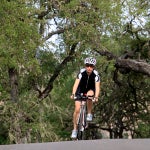New perk! Get after it with local recommendations just for you. Discover nearby events, routes out your door, and hidden gems when you sign up for the Local Running Drop.

Last March I made a trip up to Boulder, Colo. with Cannondale’s marketing director, Bill Rudell, to meet with two-time reigning Ironman world champ Chrissie Wellington and 2007 Ironman 70.3 world champ Mirinda Carfrae. The purpose of the trip was to talk to Wellington and Carfrae about their bike of choice, the Cannondale Slice. Both will be in Kona this year, with Wellington looking for her third straight victory and Carfrae competing in her first Ironman-distance race. After leaving Boulder, I found myself wondering what it was about the Cannondale Slice that intrigued these two world champs.
After a quick chat with Rudell and a couple weeks of anticipation, I found myself standing in Nytro Multisport in Encinitas, Calif. getting fit to test a brand-new red-and-white Cannondale Slice HI-MOD 1.

The Bike
Before hopping on the bike, I took some time to learn more about the engineering, geometry and components of my ride. The Cannondale Slice HI-MOD 1 is truly designed for triathletes. Engineers designed the Slice to help triathletes post a fast bike split, while also aiding in keeping legs fresh for the run. They do this by combining aerodynamic properties with vibration-damping properties.
The aerodynamic properties of the bike come as a result of two things. First, engineers worked to put riders in the most aero position possible by giving each frame size-specific tubes. Second, the tube shapes are designed to cheat the wind and reduce drag.
The Slice HI-MOD 1 features a pure Shimano Dura Ace group set, and is nicely complemented by SRAM brake levers and a Fi’zi:k Arione Tri2 K:ium saddle.
First Impressions
Then it was time for me to hop on the trainer for a professional fit. Walt, the tech from Nytro who helped me, first reacted by looking at the bike and back at me with a puzzled expression on his face. I already knew what he was thinking: How the heck am I going to fit this bike to this girl? I don’t have the stature of Wellington; I’m five-foot-three-inches tall on a good day, and my current ride has a 46 cm inch top tube and 650c wheels. The smallest Slice from Cannondale has a 51 cm top tube and 700c wheels. Walt quickly assured me that it wouldn’t be a problem, and that, with some tweaking, the bike would fit me comfortably.
Nearly an hour-and-a-half and several manipulations later, I was comfortably fit to the Slice. After heading out the doors of Nytro, I looked for my first chance to get on the road, which happened to be the following day.
A couple things about the bike stood out right away. Carrying the bike up and down the stairs of my apartment was a breeze, and the difference carried onto my first ride. The carbon fiber frame and top-notch components made an instant difference. On my current tri bike, I am constantly focusing on the weight and feel of the bike. Within the first few miles of riding on the Slice, I was focusing less on the feel of the bike and more on my stroke and positioning.

The second observation is less tech-related. On my first ride, I got several compliments on the look of the Slice. The white and red glossy paint job, as well as the unique angles of the bike make it stand out against the hundreds of tri bikes on the San Diego streets.
Takeaways
Power: Ever since I moved from pancake-flat Phoenix to the rolling hills of San Diego, I’ve been struggling to power up the hills. I immediately noticed a difference while tackling significant climbs. I felt more comfortable and powerful up every hill I tackled. Each pedal stroke took me further and faster towards the top. After returning the Slice to Cannondale and returning to my old ride, I noticed a big difference in my ability to gain momentum while climbing.
The Brick Workout: Another major benefit of the Slice didn’t come to my attention until a couple of weeks into the test period. While I had noticed how smoothly the Slice handled every bump in the road, I hadn’t realized how majorly it would benefit me once I switched my bike shoes to run shoes. My first transition run came after a 35-mile ride through Camp Pendleton. I threw on my running shoes and headed to the treadmill. The awkward, wobbly feeling in my legs that plagues nearly every triathlete during the second half of a bike-run brick wasn’t there. I felt amazing from the start and continued to feel that way to the end of the three-mile run. I have been working very hard at becoming a better runner, and had never thought that my choice of bike would affect my run performance in a brick workout or a race.
Fit: The final thing I noticed goes right back to my initial experience back at the bike shop. There were a few instances when I was pretty aware that the bike was too big for me. With time, I learned how to lean the bike so that the limited stand-over height wouldn’t be an issue when stopping during rides. I became talented at what I call the “dismount and lean,” but there were a couple instances when stopping on downhill sections almost cost me my footing on the dismount. Reaching for the breaks wasn’t the most comfortable experience, either, as my small hands often struggled to reach the levers. In all, adjusting to the size of the bike was a small price to pay for the benefits of riding on the Slice.